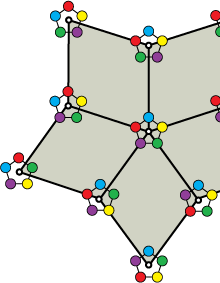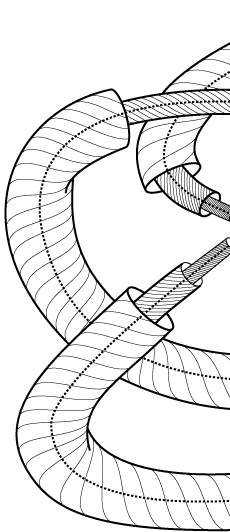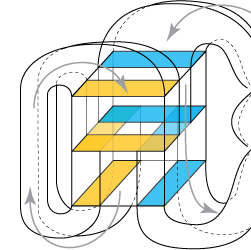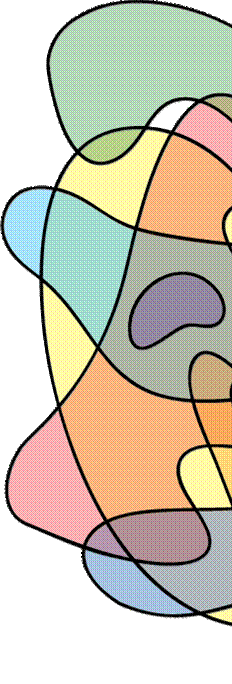


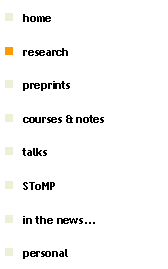
|
topological methods in applied mathematics |
|
My work focuses on those methods in applied mathematics which are topological in nature. Such methods have the feature of being very robust: topological results are tolerant of the "noise" inherent in physical systems. Such techniques are therefore both elegant and effective in engineering and science.
|
|
research summary |
|
robert ghrist |
|
Algebraic topology for sensor networks: As technology for sensors progresses, we will be able to replace large, expensive global sensors with swarms of small, cheap, local sensors. One problem facing the sensors community is how to integrate local data into a global picture on an environment and how to manage the information overload. Imagine, for example, that you have thousands upon thousands of mobile video cameras and one of them catches something important. How should the system self-organize to trap the event? And, to make it interesting, lets assume that you do not have GPS, range finders, orientation sensors, or a compass. What now? Fortunately, topologists solved a similar problem of going from local combinatorial data to a global picture (about a hundred years ago). Homology theory is surprisingly effective at answering questions about coverage and other problems in sensor networks. Recent advances in computational homology and persistent homology make these classical theories newly relevant to a wide variety of problems in security and communication. Sheaf theory is surprisingly useful in data aggregation problems over networks: a simple sheaf-theoretic integral using the Euler characteristic as a measure is very effective in problems of target enumeration over networks. Current work in progress is trying to adapt this theory to a topological version of nonparametric statistics using Lyusternik-Schnirelman category.
Topology and geometric group theory in robotics: Robotics is an ideal domain for a mathematician to work in: here, one has a genuine need for rigor. Imagine trying to verify that a control system for a robotic brain surgeon works. Would you prefer to have a successful computer simulation or a theorem guaranteeing performance? (Answer: get both if you can...) I use methods and ideas from topology and geometric group theory to prove rigorous theorems about robot motion-planning and control. In particular, I have worked with spaces of nonpositive curvature as applied to metamorphic and reconfigurable robots, and also to robot coordination problems. I am currently working on using CAT(0) geometry to answer questions about pursuit-evasion algorithms and optimal planning.
Contact topology and fluid dynamics: Rigorous results about fluid dynamics are rare for fully three-dimensional flows. I use global techniques from contact topology (an odd-dimensional variant of symplectic topology) to prove results about the most difficult classes of steady inviscid fluid flows. These techniques, e.g., contact homology, can be used answer questions about concrete physical phenomena such as hydrodynamic instability. Here are a few examples of the kids of results one can prove: 1. Any steady inviscid fluid flow on a sufficiently smooth Riemannian 3-sphere has a closed flowline which traces out an unknotted particle path. 2. There exists a steady inviscid fluid flow in 3-d (under a non-Euclidean geometry) which possesses closed flowlines of all knot and link types. 3. For a generic Riemannian structure in 3-d (with periodic boundary conditions), all curl eigenfields (non-zero eigenvalue) are hyrdodynamically unstable (linear, L2 Euler instability)
Knots, links, & braids in dynamical systems: One of the ways in which topological methods most directly impact applications is via differential equations: much of the history of dynamical systems theory traces back to topological perspectives. I have contributed to the relationships between knot theory and dynamics. One way in which these fields interact arises whenever you have a vector field on a three-dimensional domain: periodic orbits naturally trace out simple closed curves. In what ways do the knotting and linking data reflect or indeed force dynamical data? There is a rich theory here, including simple examples of differential equations for which the most chaotic types of knotting imaginable are present: all knots and links are present as structurally stable periodic orbits. Recent work has focused on applications of braid theory to scalar parabolic PDEs via a topological version of the comparison principle. This involves using Conley's version of Morse theory. |
|
specific interests |
